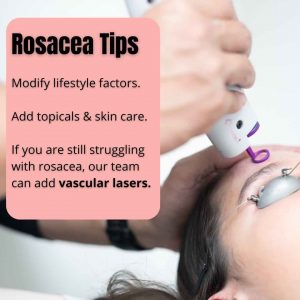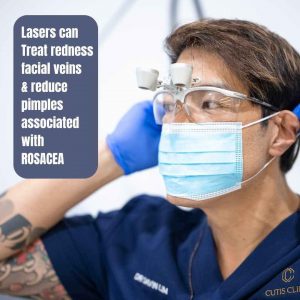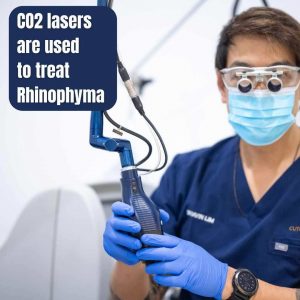- Best ResultsVariable
- Treatment Recovery1-10 days
- Procedure Time5 to 60 minutes
- Skin SpecialistDermatologist
- Duration of ResultsCan be permanent
- AnaestheticBlocks
- Back to Work0-6 days
- Cost$-$$
Rosacea Lasers
Lasers remain a useful modality for treating rosacea. They can reduce background redness, broken capillaries, inflammation & treat skin thickening of rosacea, including rhinophyma. My team and I use vascular lasers in different wavelengths to target both superficial and deep vessels.
FactsFacts on lasers for rosacea
- Lasers target redness & can help reduce skin inflammation
- The most common type of laser employed to treat rosacea is vascular lasers
- Vascular lasers in the 500 nm wavelength range treat superficial vessels
- Vascular lasers in longer wavelengths including 755, 810 & 1064 target deeper blood vessels
- IPL or intense pulse light can be useful to treat diffuse redness
- Lasers are best used with anti-inflammatory medications as this gives the fastest improvement
What is the most common laser I use to treat rosacea?
Rosacea Lasers
The vascular pulse dye laser is the commonly used method for rosacea. I use the V Beam Prima & Perfecta. It has a wavelength of 595m, with a specific cooling system known as DCD. The cooling protects the skin & reduces discomfort. Vascular lasers treat redness, inflammation & broken blood vessels.

Other lasers include the KTP at 532, the Alex at 755, diode at 810 & the long pulse NdYag laser at 1064.
How long does it take to perform laser therapy & what is the downtime?
Treatments take 8 to 14 minutes to perform. This includes calibration of the laser. I normally deliver between 50 to 300 pulses in one session. Discomfort is minimal due to the cooling system of the laser.
Recovery depends on the settings I use; typically, 24 to 72 hours. I will tell you of the expected recovery time before I laser. In some cases, I use a bruising setting to treat tiny vessels (in flushing rosacea). I will forewarn you of this treatment.
How effective are lasers for rosacea?
Lasers are best for treating redness & inflammation in rosacea patients. This includes broken capillaries as well as papules, pustules (acne like lesions) & background redness. In inflammatory rosacea, lasers work in synergy with anti-inflammatory topicals & oral agents.

Lasers are not great if you have flushing- especially if your redness is intermittent. For these cases you are better off seeing a medical dermatologist for tablets & a psychologist to manage any anxiety related issues.
What is the difference between getting lasers by a dermatologist compared to a cosmetic clinic?
Specialists use different lasers & settings compared to cosmetic clinics. Our team of dermatologists & nurses view rosacea as a medical problem. Our point of difference includes-
- State of the art equipment, with no compromise on costs.
- Specific settings based upon our experience.
- Medical or prescription based adjunctive therapy.
- Medicare rebates apply, if performed by a dermatologist.
My team is experienced in treating all types of rosacea including papular-pustular, erythothelengectaic rosacea, granulomatous, fixed type, steroid induced, ocular, otophyma, metro phymatous, rhinophymatous, flushing, neurogenic, & rebound rosacea. Each subtype will have a specific treatment algorithm.


View our Treatment Gallery
Do lasers cure rosacea?
Nope. Lasers are good for treating the signs or rosacea including broken capillaries & background redness. They do not cure rosacea. Rosacea is an intermittent condition. Lasers can place rosacea into temporary remission. The period of remission depends on many factors including your genetics, insight, & compliance.

Lasers are dismal if there is no target to hit. An example is flushing & blushing. This is best treated by a medical dermatologist.
How many treatments are required?
Most patients require 2-4 sessions, depending on the clinical picture. The higher the energy level of the laser, the less treatments required. Other factors that determine the number of sessions include-
- The activity of your rosacea
- How your skin tolerates laser
- Your skin type or skin colour
- Adjunctive therapy
- Implementation of lifestyle factors
In the capacity of how I laser, my aim is to get your rosacea under control in the fastest possible way, using as little treatments as possible.
Rosacea awareness week. Here is a summary of skin rejuvenation for rosacea patients
.
👉Avoid: retinol, retinoids, ascorbic acid, ferulic acid, glycolic, lactic acids
.
👍🏻Use: Hyaluronic acid, niacinamide, resveratrol, azelaic acid
.
👉Procedures to avoid: Microneedling, chemical peels
.
👍🏻Procedures to optimize: Vascular lasers, IPL, BBL, pico
.
😎Davin Lim
Dermatologist
Brisbane🇦🇺
.
#faceuptorosacea #rosaceatips #sensitiveskin #sensitiveskincare #rosaceaskincare
#dermatologistbrisbane
This is THE MOST EXCITING vascular laser to hit the market since the V Beam was launched many moons ago
.
👊🏻The laser: Derma V by Lutronic
.
🥸What’s so great about it?
.
👉2 wavelengths to play with
.
👉No gel to play with
.
👉Cryogen cooling: infinitely safer than gel, less mess, fire & forget
.
👉Hugely adjustable PD
.
👉Immensely powerful
.
👉Spot size is huge
.
👍🏻Knowing Lutronic, more power than advertised. Lutronic has a long history of reliability💯
.
😎Davin Lim
Dermatologist
.🇦🇺
#lutronic #vascularlaser #vbeam #dermav #laserdermatology #drdavinlim #laserscience
Rosacea, treated with V BEAM Prima, by @candelamedicalanz
.
👉Settings 11 mm spot, 6 ms, 6.5 J
.
🔫Laser: The V Beam is one of the best lasers for vascular work, primarily because of its dynamic cooling spray. I do have devices such as IPL/BBL & 1064 Nd Yag lasers with cooling plates but I personally don’t like them much
.
👍🏻Advantage of spray: fire & forget, it’s on, it’s safe, it’s more comfortable for the patient
.
👉Coupling gel & cooling plates: Adds many more steps as to what can go wrong
.
👉Gel required
.
👉Enough coupling gel needed
.
👉Cooling plate needs to be cold
.
👉Contact with the gel throughout the process
.
👉No feedback if cooling is fault
.
👉Then you gotta clean up your mess
.
👍🏻Just my 2 cents worth on vascular lasers
.
😎Davin Lim
Dermatologist
Brisbane🇦🇺
.
#vbeam #vbeamprima #rosacea #rosaceatips #rosaceatreatment #roscaeacure #rosaceaskincare
#drdavinlim #dermatoloigstbrisbane #skinscience
Rhinophyma is a form of #rosacea
.
.
🔬Skin Science: Phyma can be on the nose (most commonly), also forehead, ears, cheeks, - metophyma & otophyma
.
.
🔫Treatment: CO2 laser is the easiest, as in this case. Can do with erbium but lots of bleeding. RF loop is super fast for severe phymas. Oral isotretinoin low dose can marginally improve, but better as preventive. Massage can help mild cases as it opens up lymphatic drainage
.
😎Dr Davin Lim
Dermatologist
Brisbane🇦🇺
@drdavinlim
#rhinophyma #rosaceasupport #rosaceatips #phma #rosaceatreatment #faceuptorosacea #dermatology #dermatologistbrisbane #drdavinlim #davinlim
Can you undertake lasers without taking tablets for rosacea?
Yup, your call. In most cases laser treatment works synergistically with other treatments, including tablets. This especially applies to inflammatory papular-pustular rosacea. An exception is ETR or erythrotelangiectatic rosacea, where lasers can be employed as monotherapy.

If you have inflammatory rosacea, my usual practice is to give you a course of anti-inflammatories. This gives better results than just the laser itself. Another bonus is that I can deliver higher settings with a quicker recovery time, as anti-inflammatories decrease post laser swelling.
What is the difference between IPL & lasers?
IPL stands for intense pulse light, BBL stands for broad band light (also Brazilian Butt Lift). These devices are not lasers but filtered light. 90% of rosacea patients respond better to vascular lasers, 10% prefer IPL. Medicare does not acknowledge IPL as a treatment for rosacea, a rebate only applies to vascular lasers (performed by a dermatologist).
What is Laser Genesis for rosacea?
Laser Genesis is a marketing term used to describe long pulse Nd YAg, using the 1064 nm wavelength. It has some merit as this wavelength goes deeper into the skin compared to pulse dye lasers & IPL. The upside of this treatment is that it is super gentle with zero downtime.
Most patients undertake a series of 8 to 10 sessions. Laser Genesis can also generate dermal collagen, in turn reducing pore sizing & wrinkles. My clinical team performs this procedure.
What lasers make rosacea worse?
Lasers can help reduce inflammation, conversely lasers can increase inflammation, making rosacea worse. These lasers usually target water & include Fraxel, HALO, erbium & CO2 lasers. These wavelengths generate a tremendous amount of heat, thereby flaring up rosacea. The flipside is that I still employ these lasers in rosacea patients however I –
- Initiate anti-inflammatories before the procedure
- Modify fluence & settings
- Add LEDs & vascular lasers post treatment
What are the side effects of lasers?
In the context of how dermatologists employ lasers, side effects are uncommon. Expected effects include swelling & mild transient bruising if treatment levels are high. We will pre-warn you of this before your treatment. Side effects include-
- Blistering (less than 1%)
- Prolonged swelling (3-5%)
- Prolonged bruising (2-3%)
- Laser demarcation lines or circles (2-3%)
Can LED lasers & phototherapy treat rosacea?
LED or light emitting diodes using devices such as Omnilux, Healite & masks can marginally improve rosacea. They work by reducing inflammation. Lasers offer better results. The most commonly used LEDs emit red light (620-640 nm) as well as yellow light (diode 810-830nm). We have these devices at Cutis, hence if you would like to give it a go, book an appointment with my therapists.

What are adjunctive treatments for rosacea?
Rosacea patients should consider adjunctive medical treatments with their lasers. These include anti-inflammatory tablets as these have a synergistic effect. I normally prescribe a short course of doxycycline post laser. If you have resistant rosacea, I occasionally prescribe oral vitamin A, namely isotretinoin.
Topicals include Rozex, Soolantra & azelaic acid. I will also give you a skin care guide, including the use of washes, moisturisers & sunscreen.

How important are lifestyle changes in the management of rosacea?
Lifestyle changes are more important than laser treatment- that is a fact. Your primary goal is to control your pattern of rosacea without the requirement of medications & lasers. My job is to laser cases that are not controlled with simple lifestyle changes. See the section on rosacea tips to understand.

What is my 1% rule of rosacea?
Lasers can add to the overall percentage of rosacea improvement. Adjunctive treatments & lifestyle modifications, even in miniscule amounts count.It all adds up. For example, using the correct makeup may give a 1% improvement, changing your cleanser another 1%, niacinamide 1%, better SPF 1%, proper face washing 1%, quick tepid showers may give you 3% (bonus), & so on. In isolation one percent is not seen, but all everything up, you may get 20-60%.
What laser is used to treat rhinophyma rosacea?
Rhinophyma is end-stage rosacea. It presents as soft tissue enlargement of the nose & is more common in men. I use a CO2 laser to reshape the nose. This treatment is partially covered by Medicare. More on the specific section on rhinophyma rosacea on this website.

How can you reduce the size of your pores?
Ever noticed your pores are enlarged when you have bad bouts of rosacea? This is because skin inflammation causes swelling, in turn increasing pore size. The most reliable way to reduce pore size is with thulium 1927 fractional laser resurfacing, followed by 2-3 sessions of vascular laser. Topical anti-inflammatory medications such as niacinamide & azelaic acid can also help.
What happens when lasers fail to improve rosacea?
Remember, lasers are only part of the big puzzle of managing rosacea.
Most rosacea patients can be controlled on what I term a conventional approach. This includes.
- Anti-inflammatory washes
- Medically prescribed tablets including anti-inflammatories, & vitamin A
- Good skin care including cleansers, SPF & niacinamide
- Diet
- Stress management
- Alternative medicine
For resistant cases who do not respond to normal therapy, I employ novel treatments such as neuromodulators & devices like Tixel.
Who to see for laser treatments?
For simple rosacea laser treatments, book with my nursing team. They are experienced in the laser management of many skin conditions using an array of lasers & IPL. As a guide, their out-of-pocket cost for laser ranges between $240-$350.
I am more than happy to take on your case. Some treatments are covered under Medicare, however out of pocket costs range between $550 to $690 for vascular lasers (done by me). In most cases I perform one or two sessions of laser, then pass you on to my team. It will save you time and money as I enter the settings.

For Sydney rosacea patients, book an appointment with Lou, our experienced dermal therapist at Dr Van Park’s clinic in the Eastern suburbs.
Davin’s viewpoint on lasers & rosacea
Lasers and energy devices can be useful adjunctive therapy for inflammatory as well as phymatous & erythrotelangiectatic rosacea. My job as a laser operator plays a small part in the overall management of this condition. Other factors including lifestyle modifications are super important & contribute markedly to the control of this disease. I try to encourage patients to manage rosacea holistically, namely lifestyle, diet, topical skin care, medical treatment (if appropriate) & laser therapy.
My most frequently used laser is the pulse dye laser, either V Beam Prima or V Beam Perfecta. I tend to use higher settings early, as my mode of practice is to sort out problems in the shortest possible time, bearing in mind safety of course. Hint, if you are seeing me for laser treatment, try to book a time whereby a wee bit of swelling is expected for 1-2 days post treatment. Providing patients with insight, most will benefit from synergistic treatment. For example, lasers coupled with anti-inflammatory medications. The latter allows me to use a higher setting, hence in many cases will provide better results.
IPL or BBL, stands for intense pulse light & broad band light respectively. This consists of filtered light with vascular cut off filters. 10-20% of laser resistant patients respond to IPL, including management of ocular rosacea. The biggest downside of this treatment is that it is not recognised by Medicare for the management of rosacea.
Other lasers I use include the long pulse NdYag laser at 1064. This can be employed as a tracing laser for more persistent & resistant vessels on the nose, or as a field treatment in Laser Genesis mode. This stimulates dermal collagen, improving wrinkles & pore sizing as well as reducing background redness.
I use thermomechanofaractional services like Tixel or fractional CO2 lasers, occasionally thulium or erbium to treat resistant cases of rosacea, failing both medical & conventional vascular layers. These devices are useful in transepidermal – dermal drug delivery. The drug of choice is Botox as this can modulate smooth muscle within the vessels. Botox can also reduce demodex mite counts for up to 4 to 6 months. This treatment is useful in cases of recalcitrant flushing blushing rosacea whereby vasospasm is encountered.
Lastly, I employ an array of CO2 lasers to manage rhinophyma rosacea. This is an ablative laser used to reshape the nose. Downtime varies between 2 to 5 weeks. This treatment is partially covered by Medicare.
For Sydney patients, we employ the Excel V laser by Cutera which is very similar to efficacy to the V Beam in Brisbane. For laser appointments please contact Trace at Dr Van Park’s clinic in the Eastern Suburbs of Sydney.

